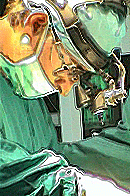|
|
|
|
|
|
|
|
Neoplasms derived from an astrocytic lineage constitute a large and heterogeneous group. They may be divided into two categories: (1) the fibrillary astrocytic neoplasms (astrocytoma, anaplastic astrocytoma and glioblastoma multiforme) and (2) a diverse group of tumor types that warrant separation from the fibrillary astrocytic series because of their distinctive clinicopathologic features. The principal members of this group include the juvenile pilocytic astrocytomas, the pleomorphic xanthoastrocytoma and the subependymal giant cell astrocytoma.
Fibrillary or fibrous astrocytes diffusely populate the brain and are especially prominent in the white matter, where their stellate processes can be identified with the historically significant but technically capricious gold impregnation of Cajal. Antibodies to glial fibrillary acidic protein (GFAP) and the immunoperoxidase method have been combined to bring a more specific and predictable technique to bear on the identification of this protein. Fibrillary astrocytes are readily seen, because their processes are rich in the "glial"' filaments which are the predominant site of this protein. At the Mayo Clinic. meanwhile, surgical pathologists were refining a four-tiered grading system for carcinomas based not on resemblance to developmental precursors, but rather on the degree of anaplasia as reflected by such characteristics as degree of nuclear and cytoplasmic pleomorphism, number of mitotic figures, and presence or absence of necrosis. From this environment emerged the Kernohan system, which divided the fibrillary astrocytomas into four grades of increasing malignancy (astrocytoma grades 1 to 4). Shortly thereafter, a similar scheme that also utilized cytologic and histologic characteristics was published by Nils Ringertz, this system differed from the Kernohan classification in having only three grades of astrocytoma (astrocytoma, intermediate type. and glioblastoma). Several "modified Ringertz" systems, all retaining the basic three-tier hierarchy, subsequently emerged. One of the most important "modifications" was a recognition of the primacy of tumor necrosis as a prognostic factor associated with the most malignant grade of astrocytomas (glioblastoma) and which separated it from the intermediate-grade (anaplastic) astrocytoma. Thus. whereas the Ringertz system permitted "very slight" necrosis in intermediate-grade astrocytomas, such neoplasms would be classified as glioblastomas in the modified systems. A three-tiered classification system has been adopted by the World Health Organization. A study by Daumas-Duport et al. found that the Kernohan grading system accurately distinguishes only two prognostic ally distinct groups: low-grade astrocytomas (grades I and 2) and high-grade astrocytomas (grades 3 and 4). In an attempt to minimize subjectivity and increase ease and reproducibility in grading, another method was introduced in 1988 by Daumas-Duport et al. which is based on the simple assessment of the presence or absence of four histologic features: nuclear atypia, mitotic figures, microvascular proliferation, and necrosis.
Neoplasms lacking all four variables (exhibiting only increased cellularity) are classified grade 1, those with one feature present are grade 2, those with two features are grade 3, and those with either three or four features are grade 4. Although both the St. Anne-Mayo and the University of California, San Francisco, grading systems have four tiers, the grade 1 astrocytomas are so comparatively rare that in practice the vast majority of astrocytomas sort into three grades, shows the approximate grade equivalencies among the major grading systems. It is obvious that specifying only a grade without reference to the particular system employed may lead to confusion; for example, a grade 2 neoplasm in the Kernohan system by definition does not exhibit mitotic figures and is more similar to an astrocytoma of the three-tiered schemes than to an anaplastic astrocytoma. Similarly, the grade 3 astrocytoma of the Kernohan system exhibits foci of necrosis and is by any standard a glioblastoma, whereas the grade 3 lesion of the St. AnneMayo system corresponds to the anaplastic astrocytoma of the three-tiered classifications.
An additional technique that may provide an indirect measure of growth potential is the quantitation of nucleolar organizer region-associated argyrophilic proteins (AgNORs). These proteins are associated with nucleolar organizer regions, which are composed of ribosomal DNA and putatively show an increase in number in the nuclei of actively dividing cells. AgNORs are readily detected with a colloidal silver stain and can be subsequently quantified. As with the proliferation markers, correlation with tumor grade, prognosis, and other indices of growth potential is currently under investigation.
|
|
|
||||||||||||||||||||||||||||||||||||||||||||||
Introduction |Imaging | Astrocytomas | Glioblastoma Multiforme | Oligodendrogliomas | Ependymomas | Pilocytic Astrocytomas | Gangliogliomas | Mixed Gliomas | Other Astrocytomas | Surgical treatment | Stereotactic Biopsy | Gliadel Wafers |Results and complications | When to Reoperate? | Colloid cyst

